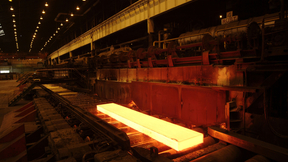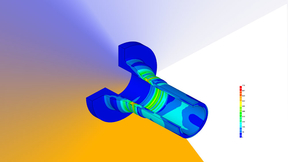Back
Officials from the National Football League visited Lawrence Livermore National Laboratory (LLNL) recently to hear how the Department of Energy’s (DOE) national laboratories are using high-performance computing and artificial intelligence to advance scientific understanding of traumatic brain injury (TBI). San Francisco 49ers chairman John York and NFL Executive Vice…
Lawrence Livermore National Laboratory (LLNL) researchers, along with scientists at the SLAC National Accelerator Laboratory (SLAC), have discovered a solution to a major type of defect in metal 3D-printed parts. Combining high-performance computer simulations with X-ray imaging of the laser powder-bed fusion (LBPF) metal additive manufacturing process obtained with SLAC’s…
The Department of Energy (DOE) and Lawrence Livermore National Laboratory (LLNL) today announced the spring 2019 call for proposals for the High Performance Computing for Energy Innovation (HPC4EI) Program, including three of its pillar programs. Managed by LLNL in partnership with other national laboratories, the HPC4EI program aims to provide industry with HPC expertise…
The High Performance Computing for Manufacturing Program (HPC4Mfg) today announced the recipients of $1.2 million in federal funding for four public/private projects aimed at solving key manufacturing challenges in steelmaking and aluminum production through supercomputing. The summer 2018 HPC4Mfg call for proposals, the sixth overall for the program, had a special focus —…
Lawrence Livermore National Laboratory (LLNL) scientists, working with researchers at University of California, San Francisco (UCSF), have developed a novel system for recording widespread brain activity, using high-density implantable devices to collect real-time data over longer timescales and across multiple areas of the brain. The new platform, as recently reported in…
Lawrence Livermore National Laboratory (LLNL) scientists and engineers have created the first research-grade, open-architecture multibeam metal 3D printer and are developing advanced diagnostics to understand the mechanics behind the multibeam process under a project funded by the Air Force Research Laboratory. To address the need for larger builds and faster print times,…
Taking a page from the past, Lawrence Livermore National Laboratory scientists and engineers are combining mechanical computing with 3D printing as part of an effort to create "sentient" materials that can respond to changes in their surroundings, even in extreme environments that would destroy electronic components, such as high radiation, heat or pressure. Original…
Deep learning is one of the most popular and widely used machine learning methods due to its success with autonomous vehicles, speech recognition and image classification, to name a few emergent technologies. But what exactly is deep learning, and how can it best be applied to Lab projects? Lawrence Livermore National Lab (LLNL) employees discovered the answers during a…
It looks like something you might find aboard the Starship Enterprise. A projector beams a three-dimensional video into a container of photosensitive resin. The video plays while the container rotates for a few minutes — then the fluid drains, leaving behind a complete, fully formed 3D object. Though it seems like science fiction, it’s not, thanks to scientists and…
A deep learning approach originally designed to teach computers how to play video games better than humans could aid in developing personalized medical treatment for sepsis, a disease that causes about 300,000 deaths per year and for which there is no known cure. Lawrence Livermore National Laboratory (LLNL), in collaboration with researchers at the University of Vermont,…
Lawrence Livermore National Laboratory (LLNL) researchers have introduced a new class of metamaterials that can nearly instantly respond and stiffen 3D-printed structures when exposed to a magnetic field, a development that could be applied to next-generation helmets, wearable armor and a host of other innovations. The Lab-developed "field-responsive mechanical…
The U.S. Department of Energy's (DOE) High Performance Computing for Energy Innovation (HPC4EI) Initiative today issued its first joint solicitation for the High Performance Computing for Manufacturing Program (HPC4Mfg) and the High Performance Computing for Materials Program (HPC4Mtls). The call for proposals seeks American companies interested in collaborating with DOE’s…
Researchers at Lawrence Livermore National Laboratory (LLNL) and the University of California, Santa Cruz (UCSC) have created 3D-printed supercapacitor electrodes capable of achieving record-breaking performance and overcoming conventional tradeoffs for supercapacitors in the process. In a paper published Oct. 18 by the online journal Joule, the joint research team…
The U.S. Department of Energy's (DOE) High Performance Computing for Energy Innovation (HPC4EI) Initiative has announced it will issue its first joint solicitation in November for two of its pillar initiatives, the High Performance Computing for Manufacturing Program (HPC4Mfg) and the High Performance Computing for Materials Program (HPC4Mtls). The call for proposals will…
The Department of Energy (DOE) today announced the first round of awardees for the new HPC4Materials (HPC4Mtls) Program, a public-private effort aimed at using high-performance computing to advance U.S. industry’s discovery, design and development of materials for severe environments. The nine projects, totaling $2.7 million in DOE funding, involve five national…
Spack, a Lawrence Livermore National Laboratory-developed open source package manager optimized for high performance computing (HPC), is making waves throughout the HPC community, including internationally, as evidenced by a recent tour of European HPC facilities by the tool’s developers. Despite its niche status, Spack (short for Supercomputer PACKage manager), is one of…
For years, Lawrence Livermore National Laboratory engineers and scientists have used an array of sensors and imaging techniques to analyze the physics and processes behind metal 3D printing in an ongoing effort to build higher quality metal parts the first time, every time. Now, researchers are exploring machine learning to process the data obtained during 3D builds in…
Lawrence Livermore National Laboratory (LLNL) engineers and scientists have developed a new technique that enhances the performance of Lab-developed flexible thin-film biological sensors, increasing the sensitivity of the implantable arrays to chemicals for biosensing applications, among other performance improvements. In the latest edition of the Journal of the…
The Department of Energy’s Building Technologies Office (BTO) within the Office of Energy Efficiency & Renewable Energy (EERE) recently awarded Lawrence Livermore National Laboratory (LLNL) researchers with $3 million for a three-year project aimed at using building energy more efficiently to shave peak electric energy usage. The project, led by LLNL power systems…
Nanoporous metals are superior catalysts for chemical reactions due to their large surface area and high electrical conductivity, making them perfect candidates for applications such as electrochemical reactors, sensors and actuators. In a study published today in the journal Science Advances, Lawrence Livermore National Laboratory (LLNL) researchers, along with their…























